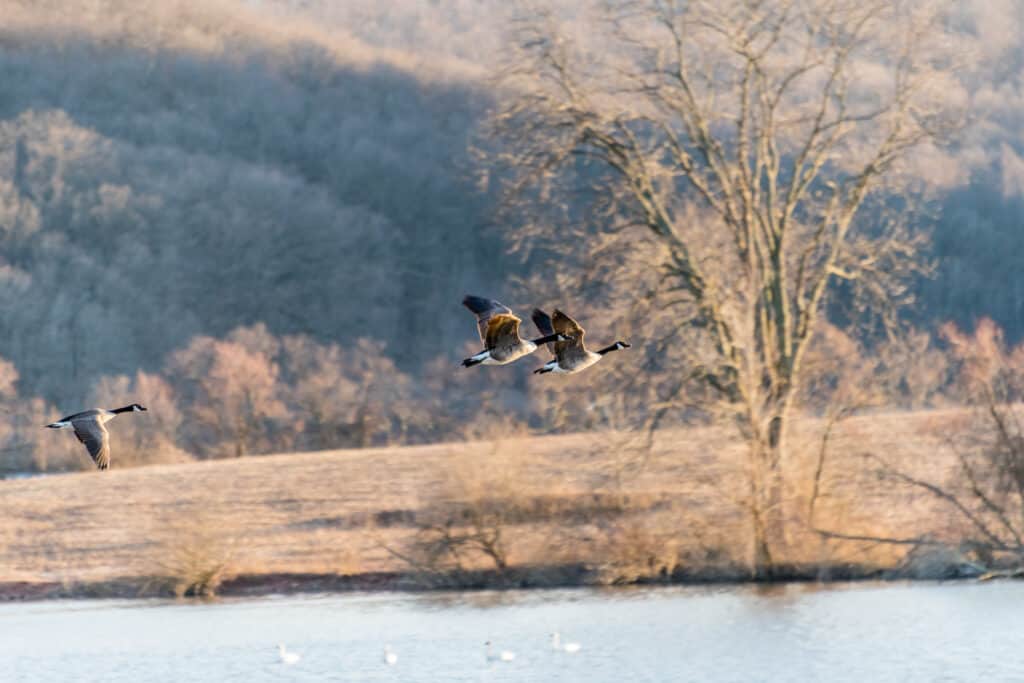People typically associate April with spring and warmer weather. After all, that’s when we expect flowers to bloom and April spring showers. However, in Pennsylvania, this month has experienced multiple heavy snowstorms throughout history.
This article explores the biggest April snowstorm ever recorded in Pennsylvania, including its impact on the state, the typical April weather patterns, and how late-season snowstorms can affect wildlife in the area.
What Was the Biggest April Snowstorm in Pennsylvania History?

In 1983, parts of central and Eastern Pennsylvania saw more than a foot of snow on April 20th.
©Marcello Sgarlato/Shutterstock.com
Pennsylvania has seen its fair share of April snowstorms, but the biggest one in history happened in 1915. The day before Easter, 19 inches of snow blanketed Philadelphia and the surrounding area. This was an unprecedented amount of snow for April. It caused significant disruption to travel and power outages across the northeast.
The late-April snowstorm of 1928 was also significant, with widespread snowfall between Pennsylvania and New York state. The storm lasted from April 27 until the 29th, with most snow falling on the 28th.
Additionally, in 1983, parts of central and Eastern Pennsylvania saw more than a foot of snow on April 20th.
Overall, it’s not uncommon for Pennsylvania to see some snowfall during April. However, these three storms stand out as some of the biggest in history.
Impact of the Snowstorm
The 1915 storm was an Easter whiteout that brought 19.4 inches of snow to Philadelphia. This made it the snowiest April on record in the city. This storm significantly impacted the region, causing transportation problems and power outages.
The heavy snowfall blocked roads with deep snow drifts, while icy conditions forced railroads to close. Falling branches and trees weighed down by the heavy snow also caused power outages, damaging electricity lines.
The aftermath of this historic storm was felt for days and even weeks in many parts of Pennsylvania. Despite its destructive force, the 1915 Pennsylvania snowstorm remains one of the state’s most remarkable weather events.
What is the Typical April Weather in Pennsylvania?
The typical April weather in Pennsylvania is mild, with daily high temperatures increasing from 57°F to 68°F. Humidity levels are low, with April and August having the lowest humidity. Rainfall is expected throughout the month, with an average precipitation of 3.2 inches.
Philadelphia’s April weather is generally mild, with average low temperatures of 45.1°F (7.3°C) and daytime highs of 59-61°F (15-16 C) early in the month, warming to 67-69°F (about 20 C) near the end.
Pennsylvania’s April weather is usually mild and pleasant, making it an excellent time for outdoor activities such as hiking or camping.
How Do Late-Season Snowstorms Impact Wildlife in Pennsylvania?

Late-season storms can disrupt migration patterns and cause animals to become stranded in areas where they cannot survive long-term.
©MH Anderson Photography/Shutterstock.com
Pennsylvania is known for its cold and snowy winters; late-season snowstorms are common. While these storms can bring joy to some, they can also harm wildlife in the state.
Late-season snowstorms can cause animals to struggle to find food and shelter, as the deep snow can make it difficult for them to access their usual sources of sustenance. This is especially true for smaller animals, such as birds, which may not reach food sources or build nests in the deep snow. Also, late-season storms can disrupt migration patterns and cause animals to become stranded in areas where they cannot survive long-term.
The cold temperatures associated with late-season snowstorms can also be dangerous for wildlife. Animals not adapted to the cold weather may struggle to survive when temperatures drop below freezing. This is especially true for young animals who may not yet have developed enough body fat or fur insulation to protect themselves from the elements.
Late-season storms can damage vegetation that provides food and shelter for wildlife. Heavy snowfall can break tree branches and flatten grasses, making it difficult for animals to find food or build nests in their natural habitats. The disruption of vegetation growth caused by late-season snowstorms can also reduce the available food sources for wildlife during warmer months when vegetation is more abundant.
Conclusion
The 1915 Pennsylvania snowstorm is an event that will never be forgotten. Its impact was felt for days, with many parts of the state still dealing with its aftermath weeks later. The late-season snowstorms that occur in Pennsylvania are part of what makes the state unique, but they can harm wildlife. It’s important to remember the potential consequences of these storms and take action to help preserve and protect Pennsylvania’s natural ecosystems and wildlife populations. By doing our part, we can ensure future generations experience the beauty and wonder of this state’s incredible landscapes and diverse wildlife.
The photo featured at the top of this post is © Nicole Glass Photography/Shutterstock.com
Thank you for reading! Have some feedback for us? Contact the AZ Animals editorial team.






